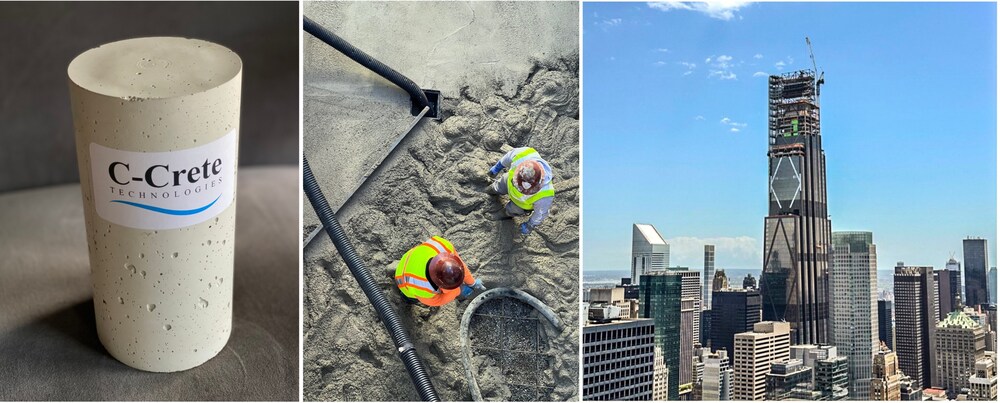
C-Crete Technologies Receives $10.4M in Grants From California Energy Commission and U.S. Department of Energy to Scale Up its CO2-Free Concrete Products
Published by Todd Bush on October 8, 2024
The company previously demonstrated the successful use of its cement-free concretes in multiple construction projects in North America.
SAN LEANDRO, Calif., Oct. 7, 2024 /PRNewswire/ -- C-Crete Technologies – a pioneer in the invention and development of Portland cement-free concrete products – was recently awarded grants totaling $10.4 million from the California Energy Commission and the U.S. Department of Energy to help the company scale up its carbon emission-free concretes. This funding reinforces C-Crete's mission to revolutionize the construction industry with its eco-friendly concrete solutions.
C-Crete’s cement-free products have been used in various projects including in a commercial building in Seattle and a supertall building in Manhattan. Photo Credits: C-Crete Technologies and Don Davies.

C-Crete’s cement-free products have been used in various projects including in a commercial building in Seattle and a supertall building in Manhattan. Photo Credits: C-Crete Technolpgies and Don Davies.
>> In Other News: Fuel Cell and Hydrogen Energy Association Celebrates Tenth Annual National Hydrogen and Fuel Cell Day
This funding shows confidence in C-Crete's Cement-free Concrete products (called C-Cretes) and recognition that these novel materials align with both California's and the DOE's missions to foster innovation in clean and sustainable technologies in the carbon-heavy construction industry. It highlights the potential of C-Crete's innovations to significantly reduce carbon emissions in the built environment.
The support also underscores the potential of C-Cretes – which use plentiful natural non-carbonate rocks rather than Portland cement as their binder – to transform concrete, the world's most abundant manufactured material. This approach eliminates CO2 emissions during production and captures carbon from the air during the curing process.
The use of Portland cement accounts for approximately 8 percent of all global CO2 emissions, primarily due to the release of CO2 during the burning of limestone in its production. Whereas C-Cretes use non-carbonate rocks rather than limestone, release no CO2, and even capture it from the air during the curing process.
Since last year, C-Crete has introduced and poured its concretes in building projects around the U.S. and Canada, including in a supertall in Manhattan in July. The successful use of the products proves that substantial carbon-emission reduction in the construction sector is possible, while still retaining concrete as an inexpensive building material.
C-Cretes meet the industry standards set by ASTM International for the mechanical and durability properties of concrete. They have more than 5,000 psi in compressive strength, and flow and pump like conventional concrete, while maintaining cost parity. This makes them a viable alternative for a wide range of construction applications.
Moreover, the reserves of each of the rocks used in the company's construction materials – such as zeolite, granite, and basalt – exist in abundance on every continent, with deposits equaling or exceeding those of limestone.
"We are very pleased that the state of California and the DOE support our science-based technology and manufacturing goals of reducing the environmental footprint of the construction industry," said Rouzbeh Savary, Ph.D., founder and president of C-Crete Technologies. "Scaling up C-Crete's manufacturing process using non-carbonate rocks moves us closer to our goal of converting locally available materials into cementitious binders for use in homes, schools, hospitals, and other infrastructure everywhere."
About C-Crete Technologies
C-Crete Technologies is a leading materials science company committed to inventing, building, and scaling up the next generation of infrastructure materials with ultra-low or negative CO2 footprints. With a relentless focus on environmental stewardship and technological innovation, C-Crete aims to address the global challenges of climate change while delivering superior infrastructure materials at scale.
SOURCE C-Crete Technologies
Subscribe to the newsletter
Daily decarbonization data and news delivered to your inbox
Follow the money flow of climate, technology, and energy investments to uncover new opportunities and jobs.
Latest issues
-
How 45Q Credits Revived This Troubled $9B Megaproject
Inside This Issue 💰 How 45Q Credits Revived This Troubled $9B Megaproject 🍁 Commencement of First Phase Operations for a Carbon Capture and Storage (CCS) Project in Canada 🤝 Haffner Energy Secures...
-
The Deal Structure Everyone's About to Copy
Inside This Issue 💼 The Deal Structure Everyone's About to Copy 📈 Exxonmobil Raises Its 2030 Plan – Transformation Delivering Higher Earnings, Stronger Cash Flow, and Greater Returns ⚡ Nextera Wor...
-
Inside XCF Global's $300M Bet to Double U.S. SAF Output
Inside This Issue ✈️ Inside XCF Global's $300M Bet to Double U.S. SAF Output ⚙️ Capsol Technologies Signs MoU with US Utility to Deploy CapsolGT® for Low-carbon Gas Power Generation 🏭 Babcock &...
Company Announcements
-
Clean Planet Technologies (CPTech), part of the Clean Planet Group, has announced that its core pyrolysis-oil upgrading process has now been formally patented in both the United States and Saudi Ar...
-
(December 12, 2025 - Oslo, Norway) Nel ASA (Nel, OSE: NEL) is pleased to announce that following a seven-year development program, and now a successful start-up and production of clean hydrogen on ...
-
Hydrogen Technology Venture Launches in Bowling Green
BOWLING GREEN, Ky. — A new tech company is coming to Bowling Green, bringing dozens of jobs to Warren County. What You Need To Know UFS ARK will be a joint venture of United Fiber Sensing and OgM...
-
HyOrc Positions Green Methanol as the Economic Solution to Shipping’s Decarbonization Challenge
HOUSTON, Dec. 12, 2025 (GLOBE NEWSWIRE) -- HyOrc Corporation (OTCID: HYOR), a fully SEC-reporting clean-energy company focused on decarbonizing heavy industry, today commented on the growing global...